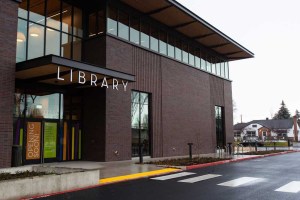Bend-La Pine school district cracks down on e-bike use for young riders
Published 5:45 am Tuesday, April 2, 2024

- An e-bike, left, sits at the bike racks in front of Pacific Crest Middle School in Bend on Monday morning.
Students under age 16 who commute to school on an e-bike have less than a week to find a new way to get there.
That’s because Bend-La Pine Schools will enforce a state law, on all school district properties, that bans anyone under 16 from operating an e-bike. E-scooters also fall under the rules.
Trending
The ban, announced in a school district newsletter last month, comes amid heightened concern over the safety of young e-bike riders. Reports of young teens violating traffic rules, riding without helmets and texting have become common in Central Oregon’s biggest city.
“After an initial warning, the school will hold the bike or scooter for a parent or guardian to pick up the same day,” said Scott Maben, a spokesperson for the school district.
Bend officials struggle to respond to mounting concerns around young e-bike riders
E-bike regulations in Oregon could be revised in response to Bend tragedy
Trending
Repeat offenders of the new rule, and their parents, will be called into a meeting between school officials, said Maben. A school resource officer — a Bend Police officer assigned to the school — could be part of the conversation.
Law passed after e-bike death
Lawmakers took notice last year after 15-year-old Trenton Burger died after being struck by a vehicle in east Bend while riding an e-bike.
The Legislature this year passed House Bill 4103, known as Trenton’s Law, which updated laws related to e-bikes. It was introduced by Rep. Emerson Levy, D-Bend, and established 16 as the minimum age for any e-bike, even pedal-assisted bikes. The previous law from 1997 was less specific and mainly geared toward bikes for people with disabilities, but also barred users younger than 16. Gov. Tina Kotek signed the bill it into law March 20.
“When our community lost Trenton, we came together in hopes of taking action to prevent the loss of life from ever happening again,” said Levy.
The previous law led to confusion of what was enforceable. “Now the intent and definitions are clear,” said Levy. “The law about 16 (year-olds) was not changed but legally clarified.”
Those legal clarifications define three separate classes of e-bike and specifically state that one must be 16 to ride any of them. It also clearly defines bikes on the market now. Because the technology is new, e-bikes as they exist today are different from those of 25 years ago, hence the need to update terminology and bike classifications.
“The legislative intent is now clear as well,” said Levy. “Previously the intent was regarding people riding bikes with disabilities.”
E-bike use among young teens has resulted in collisions and injuries, plus some close calls with school buses, Bend-La Pine Schools said in its newsletter.
Bend Police spokesperson Sheila Miller said officers have been called to assist in accidents involving e-bike riders under 16. Some accidents involved serious injuries to pedestrians or the e-bike rider.
“This is part of why we’ve spent so much time trying to educate members of our community about e-bike rules so that we don’t see kids getting hurt,” Miller said.
Unsafe riding by young e-bikers ramped up last spring when the weather warmed up, Miller said.
“We’re hopeful that the Bend-La Pine Schools’ new rule will cut down on some of that,” she said.
School enforcement
The school district said its enforcement of the age limit for e-bike riders would begin when students returned from spring break, but a grace period will be available for families to arrange alternative transportation. The district will take a more proactive approach to stop violators starting April 8.
Bike riders can be cited for breaking traffic laws, but there is no method to cite young teens for simply riding an e-bike.
“Right now there isn’t a penalty in statute,” said Levy. “Our focus right now is on educational programs in schools and in the community on harm prevention.”
Enforcement and penalties are components that lawmakers, law enforcement officers and others may consider in the future, Levy said.
Trenton’s Law may already be changing some school commutes. Bike shop owner Eric Power said bike racks at local schools appear more empty than normal.
“I went by High Desert (middle school) the other day where my daughter goes and I saw one e-bike whereas before there would be eight or nine out there. So I think people have already started to do it,” Power said.
But he adds that dissuading e-bike use could result in more cars on the road getting kids to school.
“Do I want to see more people in cars than on bikes? No,” said Power. “I think e-bikes are a great solution to a lot of our problems, like traffic at schools.”
Sterling McCord, owner of Bend Electric Bikes, agrees.
“You have to follow the rules… but I am super disappointed,” he said.
McCord is against allowing younger kids on e-bikes with a throttle, which he described as a “miniature low-speed motorcycle.”
But a law that leaves a door open to younger e-bike riders on pedal-assist bikes would have been better, said McCord. This type of e-bike requires the user to pedal before the motor kicks in to help ease the effort.
Trenton’s Law initially included such a stipulation for younger riders on pedal-assist bikes, but it was removed before the bill passed.
Pedal assisted bikes, combined with a safe-riding class, would have offered unique benefits to young e-bikers, said McCord.
“I think it helps them with their independence,” he said. “They are outside. They are less reliant on an adult for moving around the city.”
He adds that young teens wanting to operate an e-bike should also be required to take a safe-riding class. But keeping young teens safe on their bikes also requires changing driving habits, especially related to speed and distracted driving.
“The elephant in the room is cars,” he said. “Everybody is texting and driving.”
E-bike Classes
Class 1: electric-assisted bicycle that provides assistance only when a rider is pedaling and ceases to provide assistance when the bicycle reaches the speed of 20 mph.
Class 2: electric-assisted bicycle that may be propelled by its motor without the rider pedaling and ceases to provide assistance once the bicycle reaches a speed of 20 mph.
Class 3: electric-assisted bicycle that provides assistance only when the rider is pedaling and ceases to provide assistance when the bike reaches the speed of 28 mph and is equipped with a speedometer.
E-bike crash numbers
Last year Bend Fire & Rescue responded to 96 bike crashes needing a paramedic response.
Starting in May the department began tabulating the number of accidents that involved e-bikes.
From May to December, 87 total bike accidents were recorded. Twenty-two of them involved e-bikes.
So far in 2024, from January to March, Bend fire responded to four crashes, none involving an e-bike.








